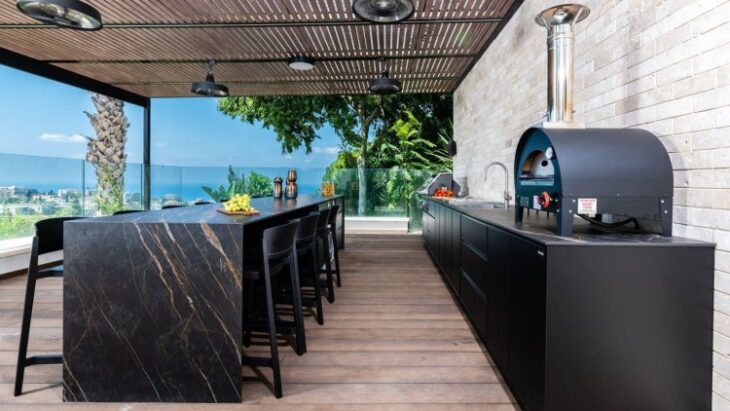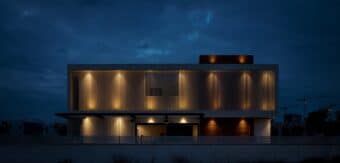Outdoor kitchens, once reserved for the yards of luxury private homes, have now made their way onto apartment balconies. You don’t even need a penthouse—just a regular apartment with a spacious enough balcony. Realizing that outdoor kitchens help sell properties, developers have caught on and are increasingly including them in their projects. So, how much does this luxury cost?
By Hadas Magen, Nadlan Center
With Israel’s Independence Day around the corner, many Israelis are getting ready for the holiday’s traditional barbecue. Some will head out to open fields with a small grill, others will fire up a barbecue in their gardens or balconies—and some will take it to the next level with a full outdoor kitchen, complete with a barbecue, sink, refrigerator, pizza oven, gas stove, kitchen cabinets, and of course, kitchenware. Instead of running back and forth between the indoor kitchen and the balcony, everything they need is right at their fingertips. Once reserved for private homes, outdoor kitchens are now becoming a popular choice even among apartment dwellers.
Developers have realized that an apartment with an outdoor kitchen is much easier to market. “Today, our default is to install outdoor kitchen preparation in every apartment, and as we move forward, we decide whether to deliver a full outdoor kitchen or just the preparation,” says Assaf Hamo, VP of Sales and Marketing at Amram Avraham. “It has become a standard. If it was once only for penthouses and garden apartments, today, in certain projects, we also install them on balconies. With balconies ranging from 100 to 180 square meters, there’s no space issue, but even an 80 square meter balcony can fit an outdoor kitchen. People want to maximize their balcony use, and an outdoor kitchen offers a fun hosting experience while keeping indoor spaces free of mess and smells.”
According to Kobi Ben Shimon, VP at DARA real estate marketing company, interest in outdoor kitchens began during the COVID pandemic when people sought open spaces beyond their four walls. There was a spike in demand for garden apartments and penthouses. Later, developers and contractors started using outdoor kitchens as a marketing tool. “An outdoor kitchen signals luxury, and when a contractor includes it, it increases a property’s desirability. In expensive apartments priced from 5 million shekels and up, customers often demand it, having paid top dollar for their homes.”
The level of demand is clear from the numbers: “In the projects we market,” Ben Shimon says, “we let customers choose between a 20,000-25,000 shekel credit or an outdoor kitchen. Most chose the kitchen.”
Outdoor kitchens have naturally become popular in luxury apartments in Tel Aviv and Jerusalem. For instance, in the Consulate Towers project in Arnona, Jerusalem—marketed by DARA—some apartments come equipped with outdoor kitchens. Since most new construction in Jerusalem consists of high-rise towers, adding luxury features like a private pool or outdoor kitchens helps enhance the appeal of these apartments.
Irit Axelrod, the project’s architect, describes the evolution of the outdoor kitchen: “What was once just a simple barbecue in private homes has evolved into a full outdoor kitchen with additional features, now considered a standard element in luxury apartments, penthouses, and apartments with large balconies.”
This trend isn’t limited to Tel Aviv and Jerusalem. DARA, for example, is marketing the Tal Premium project in the Moreshet neighborhood of Modi’in, developed by Meital Engineering, as well as the Meital Towers project in Rehovot, also by Meital Engineering—both offering mini-penthouses with the option for outdoor kitchens. Meanwhile, Amram Avraham is marketing the Aqua Park project in Ashdod, where the more luxurious apartments come with built-in outdoor kitchens. The Boulevard reale state company is currently marketing the Yehuda HaMaccabi 46-50 project—a six-story building near the Yarkon River—where the penthouse apartments feature a fully equipped outdoor kitchen on the balcony and a rooftop pool with a small adjoining kitchen.
Irit Axelrod, the project’s architect, describes the evolution of the outdoor kitchen: “What was once just a simple barbecue in private homes has evolved into a full outdoor kitchen with additional features, now considered a standard element in luxury apartments, penthouses, and apartments with large balconies.”
In the premium apartments, the outdoor kitchen is often substantial, including a pizza oven, grill, sink, and fridge. It’s not hidden—it’s part of the balcony experience. Sometimes the outdoor kitchen design matches the indoor one, maintaining style and color, and sometimes it stands independently. As Axelrod notes, very few companies make both indoor and outdoor kitchens because the materials differ significantly. Recently, more companies have been offering high-quality, fully designed outdoor kitchens.
According to Yael Moskowitz, VP of Marketing at Nyga Chef, an importer of leading kitchen brands including outdoor kitchens, the COVID pandemic dramatically accelerated this trend. “About a year after COVID began, there was a massive surge,” she explains. “People realized the situation would be long-term, saw the potential for outdoor entertaining, and discovered an entirely new experience. It quickly turned into a trend.”
Demand grew nationwide—not just in luxury areas—with adjustments made based on size, budget, and features. “While larger kitchens are common in the center and rural areas, even regular balconies sometimes feature a basic outdoor kitchen,” Moskowitz explains. “The average outdoor kitchen is about 2.5-3.5 meters long, which fits on many balconies. It typically includes a grill, fridge, sink, work surface, and storage.”
There is demand even in relatively small three-room apartments, particularly among clients in their 60s who are downsizing from spacious private homes to smaller apartments in Tel Aviv but still want the ability to entertain on the balcony. Outside Tel Aviv, smaller outdoor kitchens—about 1.8 meters long—are also popular. However, outdoor kitchens remain rare in investment properties and first homes for young couples, where standalone grills are more commonly preferred.
Nyga Chef’s outdoor kitchens start at about 50,000 shekels, but in affluent communities in the Sharon region, Savyon, and Caesarea, prices easily surpass 100,000 shekels, with some projects reaching 400,000–500,000 shekels.
According to Yael Moskowitz, VP of Marketing at Nyga Chef, an importer of leading kitchen brands including outdoor kitchens, the COVID pandemic dramatically accelerated this trend. “About a year after COVID began, there was a massive surge,” she explains. “People realized the situation would be long-term, saw the potential for outdoor entertaining, and discovered an entirely new experience. It quickly turned into a trend.”
Yossi Asraf, CEO and partner at Alumax, a manufacturer of aluminum outdoor kitchens now owned by Hamat Group, notes that the sector grew with COVID and began to attract more competitors. Alumax’s kitchens, made of versatile, durable, and attractive aluminum, start at 12,000 shekels per meter, though today you can find units for 1,500 shekels per meter. Most installations are about 3 meters long.
Asraf notes that most of the demand comes from penthouses and garden apartments in central Israel, with more and more contractors including outdoor kitchens in their projects. “I’ve already completed three or four projects with contractors, and many more are in the pipeline. Typically, they offer an outdoor kitchen as a bonus instead of a price discount, so everyone benefits,” he explains.
“A balcony with an outdoor kitchen,” concludes Hamo of Amram Avraham, “definitely adds value to a property. It’s a form of luxury and has become a real selling point, especially in high-end apartments. Wherever possible, we include it—and it allows us to command a premium.”
Moskowitz from Nyga Chef believes outdoor kitchens are still underrepresented in standard contractor packages: “Contractors haven’t yet made them a standard offering, which is a shame. Projects that include outdoor kitchens give customers added value and make apartments easier to sell.”

Nadlan Center is Israel’s leading real estate news and knowledge platform in Hebrew, created for industry professionals. Founded by experts in the field, it delivers in-depth, up-to-date coverage on urban renewal, planning and construction, taxation, and housing policy — tailored to the needs of developers, investors, planners, and financiers. In addition to its widely read news content, Nadlan Center hosts major industry events, professional conferences, and training programs that support the growth and development of the Israeli real estate sector.
Learn more: https://www.nadlancenter.co.il







